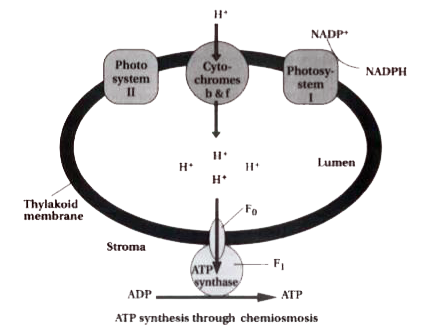Descibe Chemiosmotic Hypothesis.
To describe the process of synthesis of ATP in chloroplast, the chemiosmotic hypothesis has been put forward to explain the mechanism.
Like in respiration, in photosynthesis too, ATP synthesis is linked to the development of a proton gradient across a membrane.
These are membrances of the thylakoid.
Main difference : In respiration, protons (H+)accumulate in the intermembrane space of the mitochondria when electron move through the ETS.
Formation of protein gradient :
(a) Since splitting of the water molecule takes place on the inner side of the membrane, the protons or hydrogen ions (H+) that are produced by the splitting of water accumulate within the lumen of the thylakoids.
(b) As electrons move through the photosystems, protons are transported across the membrane.
This happens because the primary acceptor of electron which is located towards the outer side of the membrane transfer its electron not to an electron carrier but to an H carrier.
Hence, this molecule removes a proton from the stroma while transporting an electron.
When this molecule passes on its electron to the electron carrier on the inner side of the membrane, the proton is released into the inner side or the lumen side of the membrane.
Reduction of NADP :
(c ) The NADP reductase enzyme is located on the stroma side of the membrane. Along with electrons that come from the acceptor of electron of PS I, protons are necessary for the reduction of NADP+toNADPH+H+. These protons are also removed from the stroma.
NADP+2H+→NADPH+H+NADP Reductase
Hence, within the chloroplast, protons in the stroma decreases in number, while in the lumen there is accumulation of protons. This creates a proton gradient across the thyakoid membrane as well as a measurable decreases in pH in the lumen.
Importance : This protein gradient is important because it is the breakdown of this gradient that leads to release of energy. The gradient is broken down due to the movement of protons across the membrane to the through the transmembrance channel.

Stucture of ATPase enzyme :
F0 : The ATPase enzyme consists of two parts: one called the F0 is embedded in the membrane and forms a transmembrane channel that carreis out faciltated diffusion of protons across the membrane.
F1 : The other portion is called F1 and protrudes on the outer surface of the thylakoid membrane on the side that faces the stroma.
The break dwon of the gradient provides enough energy to cause a coformational change in the F1 particle of the ATPase, which makes the enzyme synthesize serveral molecules of energy - packed ATP.
Necessary elements of Chemoismosis :
(a) Chemiosmosis requires a membrane, a proton pump,a proton gradient and ATPase.
Energy is used to pump protons acorss a membrane,to create a gradient or a high concertration of protons within the tylakoid lumen.
ATOase has a channel that allows diffusion of protons back across the membrane, this releases enough energy to activate ATPase enzyme that catalyes the formation of ATP.
Requirement of Chemiosmosis :
Along with the NADPH produced by the movement f electrons, the ATP will be used immediately in the biosynthetic reactio taking place in the stroma, responsible for fixing CO2, and synthesis of sugar (C3pathway).
Topper's Solved these Questions
- PHOTOSYNTHESIS IN HIGHER PLANTSBOOK - KUMAR PRAKASHANCHAPTER - PHOTOSYNTHESIS IN HIGHER PLANTSEXERCISE - SECTION - B (DIFFERENCE / SCIENTIFIC REASONS )(GIVE DIFFERENCE : (2 MARKS)
9 Videos
- PHOTOSYNTHESIS IN HIGHER PLANTSBOOK - KUMAR PRAKASHANCHAPTER - PHOTOSYNTHESIS IN HIGHER PLANTSEXERCISE - SECTION - C (DEFINITION / EXPLANATION - TERMS / LOCATION - FUNCTION / FULL NAME) (DEFINITIONS / EXPLANATION :(1 MARK)
27 Videos
- NEURAL CONTROL AND COORDINATIONBOOK - KUMAR PRAKASHANCHAPTER - NEURAL CONTROL AND COORDINATIONEXERCISE - OBJECTIVE SECTION (FILL IN THE BLANKS)
12 Videos
- PLANT GROWTH AND DEVELOPMENTBOOK - KUMAR PRAKASHANCHAPTER - PLANT GROWTH AND DEVELOPMENTEXERCISE - OBJECTIVE SECTION (FILL IN THE BLANKS)
7 Videos
Similar Questions
Photosystem|Light Reaction|Chemiosmotic Hypothesis|Dark Reaction|The Calvin Cycle|OMR
View SolutionPhotosynthesis in Higher Plants || CAM Pathway Photorespiration (C2 Cycle ) || Chemiosmotic Hypothesis and Bacterial Photosynthesis
View SolutionWhich of the following statement is incorrect for chemiosmotic hypothesis ?
View SolutionWhat is chemiosmosis? Who proposed the chemiosmotic hypothesis?
View SolutionAccording to chemiosmotic hypothesis, ATP synthetase form ADP when protons (H+),
View SolutionThe chemiosmotic hypothesis suggests that the ATP are produced on the inner membrane of mitochondria due to :
View SolutionAccording to chemiosmotic hypothesis, ATP synthetase form ATP when protons (H+),
View SolutionThe chemiosmotic hypothesis suggests that the ATP are produced on the inner membrane of mitochondria due to :
View SolutionAccording to the chemiosmotic hypothesis of ATP formation in the chloroplast, which one does not contribute to the development of proton gradient across the thylakoid membrane?
View SolutionAccording to the chemiosmotic hypothesis, the photosynthetic ATP formation occurs during the movement of protons from
View Solution
